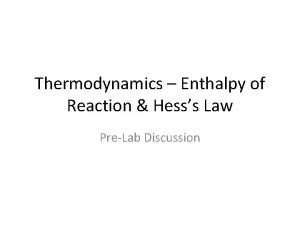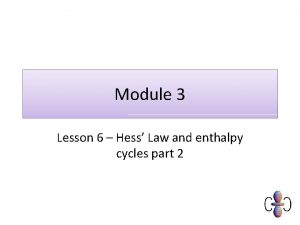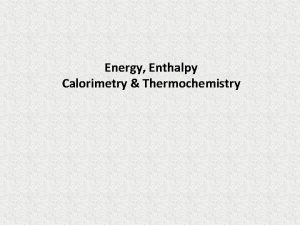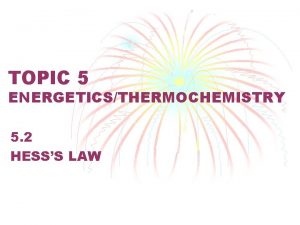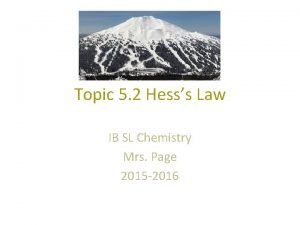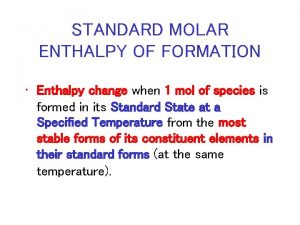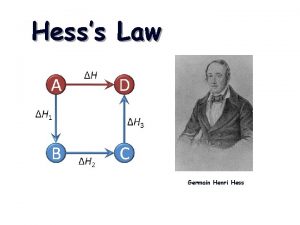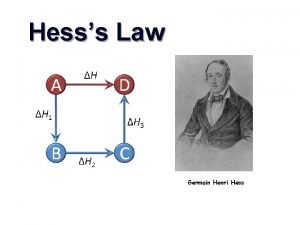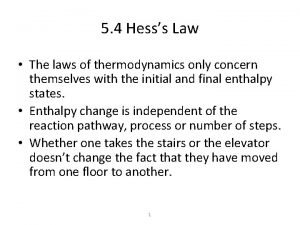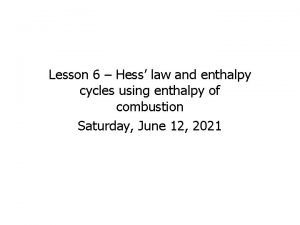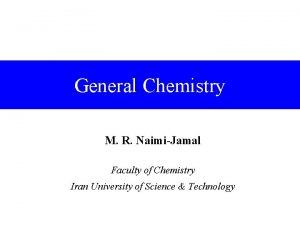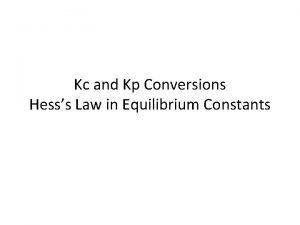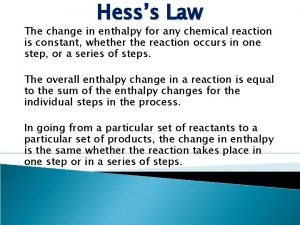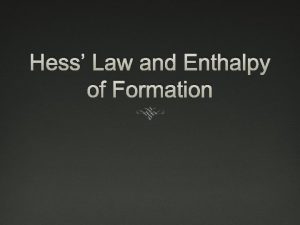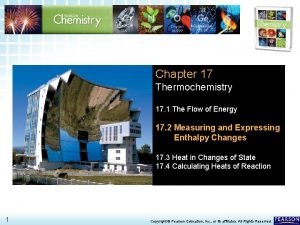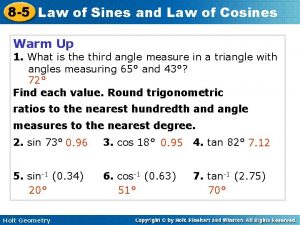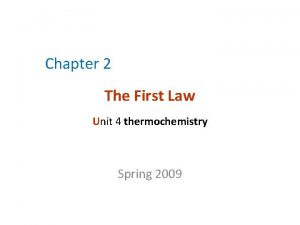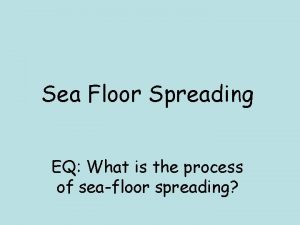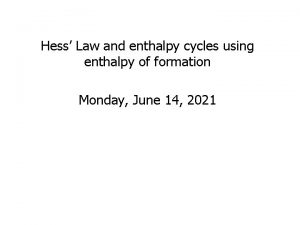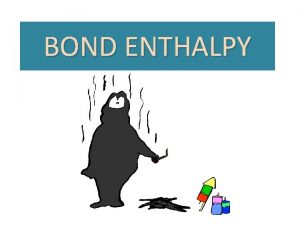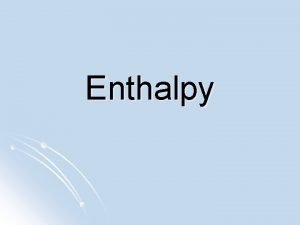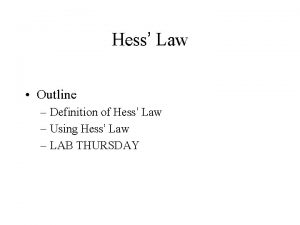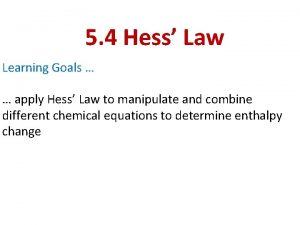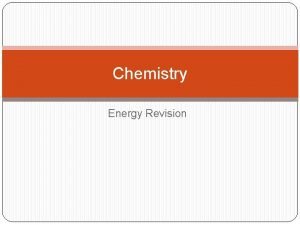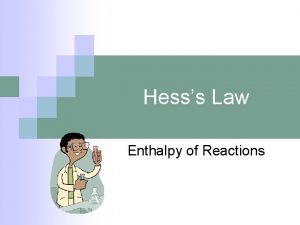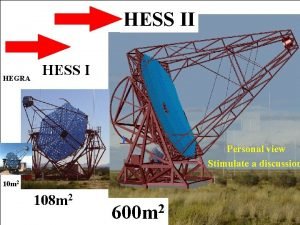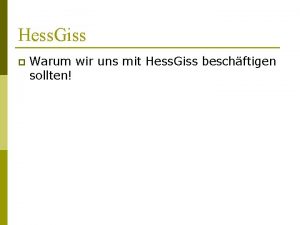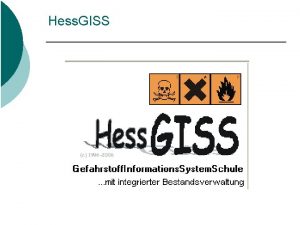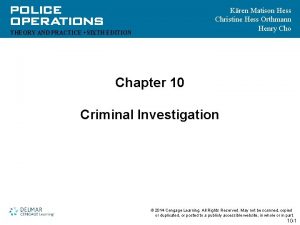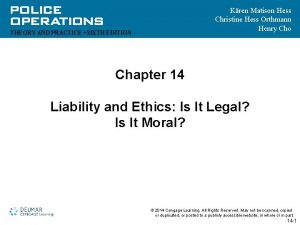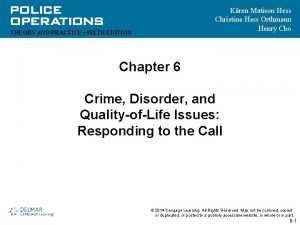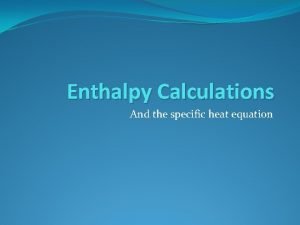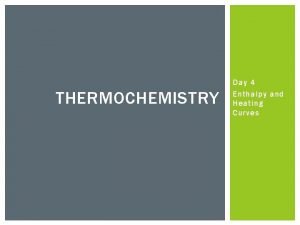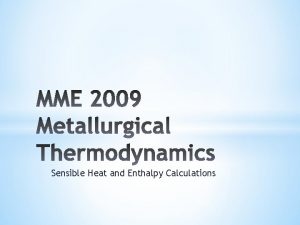Module 3 Lesson 6 Hess Law and enthalpy


























- Slides: 26

Module 3 Lesson 6 – Hess’ Law and enthalpy cycles part 2

Objectives Must Recall Hess’ law and construct an enthalpy cycle based on given data for enthalpy changes of combustion Should Extend the principle to calculate enthalpy changes of reaction from enthalpy changes of formation. Could Construct and use an unfamiliar enthalpy cycle to determine an enthalpy change of reaction.

Starter 1. Define ΔHf 2. What are standard conditions? 3. What is the value of ΔHf for any element?

Using ΔHf As with ΔHc many ΔHf values have also been measured and can be looked up in tables Products Reactants Elements ΔHr = - Σ ΔHf(reactants) + Σ ΔHf(products) Draw an – then if you follow the direction of an arrow then ADD. If opposite to the direction of the arrow then SUBTRACT.

Example You are provided with the following enthalpy changes of formation Substan ce NO 2(g) NH 3(g) NO(g) H 2 O(l) HNO 3(l) ΔHf / k. Jmol-1 33 -46 90 -286 -174 Determine the enthalpy change for the following reaction: 2 NO (g) + O 2(g) 2 NO 2(g)

Substan ce NO 2(g) NH 3(g) NO(g) H 2 O(l) HNO 3(l) ΔHf / k. Jmol-1 33 -46 90 -286 -174 2 NO(g) + O 2 (g) 2 NO 2(g) Elements ΔHr = -(2 x 90) + (2 x 33) = -114 k. Jmol-1

Example You are provided with the following enthalpy changes of formation Substan ce NO 2(g) NH 3(g) NO(g) H 2 O(l) HNO 3(l) ΔHf / k. Jmol-1 33 -46 90 -286 -174 Determine the enthalpy change for the following reaction: 4 NH 3 (g) + 5 O 2(g) 4 NO(g) + 6 H 2 O(l)

Substan ce NO 2(g) NH 3(g) NO(g) H 2 O(l) HNO 3(l) ΔHf / k. Jmol-1 33 -46 90 -286 -174 4 NH 3(g) + 5 O 2 (g) 4 NO(g) + 6 H 2 O(l) Elements ΔHr = -(4 x -46) + (4 x 90) + (6 x -286) = -1172 k. Jmol-1

Example You are provided with the following enthalpy changes of formation Substan ce NO 2(g) NH 3(g) NO(g) H 2 O(l) HNO 3(l) ΔHf / k. Jmol-1 33 -46 90 -286 -174 Determine the enthalpy change for the following reaction: 2 H 2 O (l) + 4 NO 2(g) + O 2(g) 4 HNO 3(l)

Substan ce NO 2(g) NH 3(g) NO(g) H 2 O(l) HNO 3(l) ΔHf / k. Jmol-1 33 -46 90 -286 -174 2 H 2 O(l) + 4 NO 2 (g) + O 2(g) 4 HNO 3(l) Elements ΔHr = -(2 x -286) - (4 x 33) + (4 x -174) = -256 k. Jmol-1

Other enthalpy cycles • In your AS course you have to be able to construct and use cycles that use and data. • The same principles can be applied to any energy cycle provided it is constructed correctly. , and you can’t go wrong.

Examination question • Attempt these complete examination questions from January and June 2010 under test conditions to prepare for a mid-unit test next lesson.

Question 1





Question 2




Mark schemes Cover until you have answered

Mark scheme Q 1 – cover until you have answered

Mark scheme

Mark scheme Q 2

Mark scheme
 Thermodynamics enthalpy of reaction and hess's law
Thermodynamics enthalpy of reaction and hess's law Module 3 lesson 6
Module 3 lesson 6 Calculating enthalpy change
Calculating enthalpy change State and explain hess's law of constant heat summation
State and explain hess's law of constant heat summation What is this
What is this Define standard enthalpy of formation,δhf⁰
Define standard enthalpy of formation,δhf⁰ Application of hess law
Application of hess law Molar heat of formation
Molar heat of formation Hess's law example
Hess's law example جرمان هنری هس
جرمان هنری هس Hesss law
Hesss law Hess law definition
Hess law definition 이미지 출처 표기법
이미지 출처 표기법 Calculation of enthalpy
Calculation of enthalpy Hess law constant heat summation
Hess law constant heat summation Kp formula
Kp formula Hess’s law _____.
Hess’s law _____. Hess law state function
Hess law state function Newton's first law and second law and third law
Newton's first law and second law and third law Newton's first law and second law and third law
Newton's first law and second law and third law 17.2 measuring and expressing enthalpy changes answers
17.2 measuring and expressing enthalpy changes answers 8-5 practice b law of sines and law of cosines
8-5 practice b law of sines and law of cosines Kirchhoff's law of thermochemistry
Kirchhoff's law of thermochemistry Boyle's law charles law avogadro's law
Boyle's law charles law avogadro's law How to calculate boyle's law
How to calculate boyle's law C device module module 1
C device module module 1 Harry hess and seafloor spreading
Harry hess and seafloor spreading
